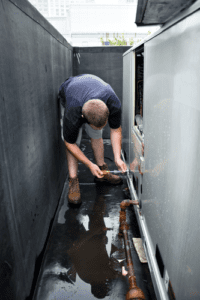Whether you are designing a brand-new commercial building for your business or replacing the HVAC system in an existing space, it’s important to pay attention to the finer nuances of commercial heating design. The design of your HVAC system will impact everything from the thermal comfort of your building to indoor air quality. A well-considered system will not only deliver a superior work environment for tenants of your building, but it will also affect factors such as energy efficiency and operational costs. Here are five of the most important considerations to keep in mind while designing your HVAC system.
Commercial Heating Design Tips
- Building design
 The best HVAC systems are not designed or chosen in a vacuum. Instead, you need to consider the entire building when putting your system together. If you are starting a new commercial construction project, you have more leeway when it comes to adjusting your building design to suit heating and cooling factors. Even if you are just renovating, though, there are tweaks you can make to pave the way for a more effective HVAC system. For instance, by adding more windows to your building—and maximizing the amount of natural light and heat—you can achieve lower heating loads during the autumn and winter months. Just be sure to use tinted windows: they’ll reduce heat from the sun in the summer, thereby cutting down on your air conditioning costs.
The best HVAC systems are not designed or chosen in a vacuum. Instead, you need to consider the entire building when putting your system together. If you are starting a new commercial construction project, you have more leeway when it comes to adjusting your building design to suit heating and cooling factors. Even if you are just renovating, though, there are tweaks you can make to pave the way for a more effective HVAC system. For instance, by adding more windows to your building—and maximizing the amount of natural light and heat—you can achieve lower heating loads during the autumn and winter months. Just be sure to use tinted windows: they’ll reduce heat from the sun in the summer, thereby cutting down on your air conditioning costs.
- Climate zones
For residential heating systems, climate zones are optional. It might be nice to heat different floors of your house to slightly different temperatures, but the need isn’t all that pressing. In a commercial building, though, having zones is a must. For a variety of reasons, different parts of your building will need to be heated or cooled to different temperatures. Rooms that are being used all the time, for instance, will probably need more heating or cooling than rooms or parts of the building that tend to go unused most of the time.
Meanwhile, lobbies or other rooms along the perimeter of your building are more likely to be affected by the weather outside. Without zones, you only get to choose one temperature for the entire building. With zones, you can have dozens of thermostats throughout the building, each capable of controlling the temperature for its own zone. It’s essential to keep zone control on your priorities list while designing a commercial heating system, as well as make sure you are segmenting climate zones logically throughout the building.
- HVAC sizing
HVAC system sizing might be the single most important consideration when designing a heating or cooling system for a commercial building. A system that’s too small won’t provide enough heat or air conditioning for the building, but a system that is too big is actually just as problematic. An oversized system will run more intermittently than is ideal, switching on and off repeatedly throughout the day. Consequences of this situation include inconsistent temperature distribution and high levels of humidity throughout the building. Your HVAC system only eliminates humidity if allowed to run for longer and more consistent periods of time. Since oversized systems reach the preferred temperature faster, they switch off before removing humidity from the space.
- Air distribution
Many homes are cooled using underfloor air distribution, while commercial buildings tend to utilize overhead air distribution. As office spaces continue to evolve and move toward wide open, high-ceiling designs, though, overhead air distribution is no longer the optimal choice for many buildings. In more open spaces, underfloor air distribution is better for comfort, energy efficiency, and air quality. Ultimately, though, which choice is best for your building will depend on the design of the space.
- Ventilation
Heating a building effectively isn’t just about heat. There is a reason that the abbreviation “HVAC” includes the letter “V” for “ventilation.” We already mentioned how proper planning for air distribution can improve air quality. However, making sure you have a proper design for air intake and overall building ventilation is a must for eliminating odors, dust, bacteria, and even humidity from your space. In other words, make sure to bring up the ventilation side of things when consulting with your HVAC expert. They should be able to provide some pointers on how you can effectively filter and ventilate the air throughout your building.
Conclusion
Simply put, there is no one-size-fits-all solution when it comes to commercial heating design. There is no “correct answer” for any HVAC consideration. Instead, you will need to look at the design of your building or office space and make decisions accordingly. Working with a trusted HVAC professional can help you understand these considerations so that you are making the choices that make sense for your building and its future tenants. In turn, making the right calls now will deliver greater levels of comfort, efficiency, affordability, and health in the future.
Valley Comfort conducts commercial heating services in the following communities: Santa Rosa, Napa, Rohnert Park, Healdsburg, St Helena, Calistoga and Windsor.
